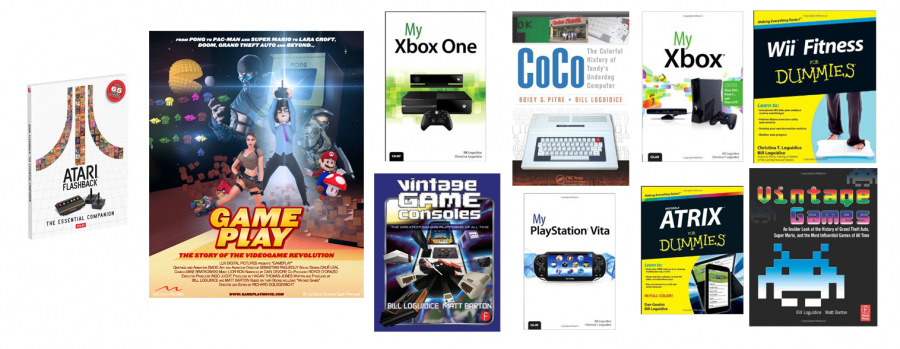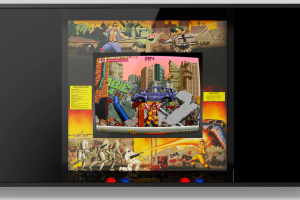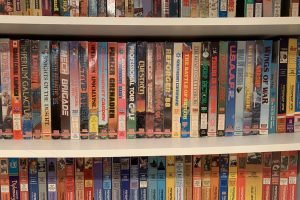After I made the announcement on social media that I was auctioning off my videogame and computer collection, I received a lot of questions both public and private simply asking, “Why?”. Before I answer that, some background.
I was born in 1972, so grew up as personal computing technology in all its forms grew up. Whether early videogames or early computers, I was pretty much there every step of the way. As I’ve recounted in multiple interviews, one of my earliest memories is sitting on my mother’s lap and happily playing with some type of pocket calculator. I couldn’t have been more than 3 (I also loved messing with the kitchen phone on the wall; I even accidentally called the plumber once). After we got our first Pong system a few years later – a Sears Tele-Games model – my passion for this type of emerging technology was well and truly set. Even then, I couldn’t get my dad to hook it up to the TV enough times (for some reason it wasn’t permanently attached) to satisfy my desire to play it.
Fast forward a few years to age 7 and using my Communion money to buy my very own Atari Video Computer System (aka, 2600). My mom thought the purchase foolish and that it would be something I’d soon tire of like my other toys. Even with initially only having the two player-only Combat cartridge, I absolutely did not tire of it (many articles, books, and a movie later, and helping to work on the latest versions of the Atari Flashback systems, I’d say that initial investment – and continued passion – paid off).
I was a voracious reader of Electronic Games magazine, a publication that was extraordinarily influential to me, starting with my initial purchase of the June 1983 issue in a local Foodtown supermarket. It covered just about every noteworthy videogame and computer system of the time, and I’d often “drool” at the various screenshots, or, fairly common for the time, artist renderings/mockups. Between the magazine, the occasional arcade game, and my Atari 2600, my interest in getting to experience all of the other games and platforms grew ever more intense. Naturally, being a kid, my ability to actually use all of that stuff, let alone buy it, was supremely limited.
In any case, I got my first computer, a Commodore VIC-20, when I was 10, which was soon replaced by a Commodore 64. My friends also started to get systems of their own around this same time, with Apple II’s, Atari 8-bit’s, TI-99/4a’s, Mattel Aquarius’s, Mattel Intellivisions, and others being added to what I would get at least some first-hand experience with. At a local Odd Lots, I was able to get a ColecoVision.
Without adding more length to the story, needless to say, my appetite for this stuff was never really sated. Even before it really had a name, I was a videogame and computer collector. I had little interest in letting go of the systems I had and getting to experience other systems either at my friends’ houses or at school, only added to my desires. Here and there I would get more games and soon enough, more systems, particularly as the 1980’s wore on and other people were moving on from them.
Into the 1990’s, it was still fairly easy to find great stuff at yard sales, flea markets, computer shows, and the like, sometimes for just a few dollars. My collection continued to grow, although what I could acquire was slowed by college and not really having the time/space to make use of much of it. Even when I first moved out of my parents’ house at 23, my first apartment could maybe hold four or five systems comfortably. Eventually I was able to move to a condo with my future wife, then a house, then a bigger house, being able to liberate the rest of my collection from my parents’ basement and garage along the way.
After getting my first book deal in 2005, I used that as an excuse to greatly expand my collection since I could now also have a dedicated room for all my stuff (this is the “then a house” one). It was indeed for “research” and “first-hand experience” and what-not, but it was also because I really wanted it. Of course, by this time, eBay was already a big deal, so that became both a blessing and curse to collectors everywhere. You could find far more stuff easily, but it was no longer for a low price. That also effectively killed most other value-based sources that proved so fruitful in the 1980’s and 1990’s, like the aforementioned flea markets and computer shows.
Although my collection grew dramatically in that time, it was still relatively self-contained to just one room. That didn’t make moving to the next house (this is the “a bigger house” one) any easier, though. In fact, my collection was among the last things we moved, with help from various extended family members. It was definitely a burden. Unfortunately, the bigger house we moved to was yes, bigger, now with an enormous partially finished basement. My collection could and would now get completely unhinged, particularly as Armchair Arcade grew, I wrote more articles, and of course, worked on more books and the movie. More excuses to make use of my stuff meant even more stuff.
Now, as I implied earlier, I’ve pretty much had an interest in every aspect of videogames and computers. I’d say the vast majority of collectors and enthusiasts limit themselves to one or a handful of platforms to focus their attention on. For me, that was never enough. I truly loved it all. My collection encompasses systems from every part of the world and every era. I’m equipped to run systems with just about any power or display requirement. I could satisfy every curiosity.
What I think would probably be most surprising to those not into this kind of stuff, is that not only is there all the original hardware, software, accessories, etc., available, but practically every system – including some of the most obscure stuff imaginable – has thriving communities creating new things. Yes, new software, new ways to better use the old equipment in modern times (flash carts, connectivity, etc.), and more. That only adds to the things to get. While this can be manageable if you limit yourself to a handful of platforms, multiply that by hundreds of platforms and you see where the problem comes in.
Now, we get to the crux of the matter. I was always pretty organized with my stuff. This was relatively easy for me even into the early 2000’s. Unfortunately, once I had that basement to fill and different rooms to work on and use different systems, that’s where the problem came in. As demands on my time grew – at one point I was working on three books at the same time – as I would use these various systems, I’d either be too tired or too disinterested in putting everything back neatly. The more stuff, the harder it is to easily use without unpacking a bunch of stuff, moving other stuff, etc. My basement hasn’t recovered since, since I haven’t had the many days (or energy) to devote to getting it in order. And even with as large as my basement is, I don’t even think I have the room for everything that’s there anymore. That’s what leaving stuff around does — makes it seem like you have room where you really don’t. The floor is not a storage place.
I have a full-time job and several side jobs (fortunately, passion, not necessity), as well as a wife and three kids. My passions for videogame and computer stuff has never waned, either, so I have all the latest consoles and a great gaming laptop. All of those things take time and it’s time I want to spend on them, which leaves very little time left for older stuff, particularly older stuff that’s just not easily accessible and/or quick to set up.
In fact, one of the reasons for my comfort in moving away from physical items now has been the trend in modern consoles and computers to be all digital. Digital stuff – no matter how many thousands of items you actually have – takes up no physical space (let’s ignore for a moment what ownership of something digital really means). That’s in sharp contrast to how things previously worked. It also helps that I genuinely enjoy how the modern stuff works, and in my middle-aged adult life, convenience is something I prize since my time is more precious than ever.
One thing I’d like to stress through all of this is that I never put my collection ahead of more important things. I always placed my wife and eventually kids as my first priorities, and never sacrificed working hard at a good job and doing right by both me and my family. I resolved to succeed at my passion projects/interests without sacrificing the stuff that I deemed truly important. And even as my collection became untenable, I never let it spill out beyond the basement (at least much!). So yes, while I have an all-consuming passion, I still made sure it had its limits.
So what does all this mean? It means that psychologically I’m in a great place since I can continue to pursue my passions, albeit with far less stuff bogging me down. By partnering with Bodnar’s Auction, I can get rid of everything, save for a precious few systems with minimal extras. I no longer have to feel guilty about keeping stuff I’ll never get to use (no matter how much I want to) out of the hands of people who might make more use of it. Unfortunately, I’m not taking requests for individual items, since that defeats the purpose of doing this all in one shot. Bodnar’s Auction has agreed to put my 100 best items up (although, honestly, that’s going to be hard for me to figure out) for auction online as well as at physical auction. Everything else will be strictly physical auction. The timetable right now looks like the auction will take place some time in March or April 2018, and may be part of their grand opening event at what they expect to be a new permanent location (still in New Jersey).
As always, I’ll be happy to answer any questions. I also ask that when the time comes, to please help me spread the word. I’ll definitely be posting about this again once the auction is officially scheduled. While obviously I have a financial interest in making this a success, I’m still first and foremost a member of the community, and I really do want to see the people who would appreciate this stuff the most get it before anyone else. As good of a decision this is for me, it was definitely not an easy one.
For those interested, here’s a small selection of the platforms that should be part of the auction (of course there’s tons of boxed software and accessories, collectibles, etc.):
3Com Palm IIIx
Acorn BBC Master/Micro/Electron
Amdek PC
Amstrad CPC464/6128/GX4000/PPC640
APF Imagination Machine/M1000/MP1000/TV Fun
Apple II/IIGS
Apple Mac
Arcade Retro Collecting Multiple Classic Computer (MCC-216)
Archos 7 (6700)
Asus Eee Pad Transformer TF101-A1/EeePC 1000HE
AT&T PC 6300
Atari 8-bit/ST/Stacy/Falcon/2600/5200/7800/XEGS/Flashback/Jaguar/Lynx/Portfolio/Video Pinball
AtGames (various)
Bally Professional Arcade (Astrocade)
Briel Computers Altair 8800 Micro/Micro-Kim/PockeTerm/replica 1
Cambridge Computer Z88
Coleco Adam/ColecoVision/Telstar
Commodore 128/64/Amiga/PET/CDTV/CD32/Plus-4/C16/SX-64/VIC-20
Compaq Deskpro
Cyberpower GUA290
Cybiko Wireless Entertainment System/Xtreme
Dell (various)
Dick Smith Wizzard (VTech CreatiVision)
Dream Authentics Excalibur Home Arcade Machine
dreamGEAR Plug ‘n’ Play 50 in 1
EB Excalibur Fox Sports Football Key Chain
Emerson Arcadia 2001
Enterprise 128
Entex Handhelds
Epoch Cassette Vision/Super Cassette Vision
Epson HX-20/Epson PX-8
Exidy Sorcerer
Fairchild Channel F System II/Video Entertainment System (VES)
FC Mobile FC Mobile II
Franklin ACE 1200
Gadgets Small, Inc. Spectre GCR
Game Consoles Worldwide GCW Zero
Game Sporz TV Wireless Boxing
GamePark Holdings GP2X F-200
Gateway CX210X Tablet PC
GCE Vectrex
Generic PCs
Generic Pocket Arcade 256 Games in 1
Generic Talking Brick Game 118 in 1 – E-118T
Gold Leopard King (GLK) GLK Book Education Computer M08
Grundig Super Play Computer 4000 (Interton VC 4000)
Heathkit HERO JR RT-1 (robot)
Hewlett-Packard HP TouchSmart IQ524/HP-85/Pavilions
Hyperkin GenMobile/NES RetroN 1/RetroN 5
IBM 5155/5150/PCjr
indieGO Odroid XU4
Intelligent Game MPT-03 Home Entertainment Centre
Interact Home Computer System (Model “R” – 16K)
INTV Corp. Intellivision III
Jakks Pacific Dora the Explorer TV Game/Namco TV Games/Star Wars Blaster Strike Video Game
jojoultimate Mini Universal Supergun (SuperGun, super gun)
Kaypro Kaypro 4 (Kaypro 4 ’84)/Kaypro II
Konami Konami Live Online Game Controller!/Handhelds
Laser 128 EX-2/Compumate2
Leapfrog Leapster2
Lego Robotics Invention System 2.0
Magnavox Odyssey/300/Odyssey2
Mammoth Toys Commodore 64 30 Games in One Joystick! (DTV)
MatchMaster MMDB04
Mattel Aquarius/Radofin version/Baseball/Enhanced Computer System (ECS)/HyperScan/Intellivision/II
Maximite BasicBoxX (BBX) Computer
MBR Control Dynamics S-100 Bus Chassis
Memorex Spongebob Media Player
Memorex Video Information System Player (VIS)
MFJ Video Effects Titler 1480B
MGA Entertainment (various)
Microsoft Xbox/360/One
Midway TouchMaster 5000 (arcade machine)
Milton Bradley MBX Expansion System/Microvision
Multitech Micro-Professor 1 (MPF-1)
MX Plus Android TV Box
Navman PiN Pocket PC
NEC Mobile Pro 750C/PC Engine Super Grafx/PC-6601/PC-8001A/PC-FX/NEC Trek PC-6001(A)/Duo/Express/16
Next Thing Co. PocketCHIP (PocketC.H.I.P.)
Nintendo 3DS/64/DS/GBA/GB/GBC/GC/SNES/NES/Famicom/Wii/Wii U
Nixdorf Computer LK-3000
Nokia N-Gage QD
Ohio Art Etch A Sketch Animator 2000
Ohio Scientific Challenger 1P
OnLive OnLive Game System
Oric Oric-1
Osborne Executive (OCC-2)/Osborne 1 (OCC-1)
Oscar Vermeulen KIM Uno/PiDP-8/I
Packard Bell Platinum
Palm Z22
Panasonic FZ1 3DO Interactive Multiplayer/JR-200U Personal Computer/RL-H1400 HHC
Philips CDI/Videopac G7200/Videopac+ G7401
Pimoroni Picade
Pioneer LaserActive
Pro Tech Video Game System
Radica Sega Menacer/Space Invaders
Radio Shack Color Computer/2/3/LCD Space Rescue/MC-10 (Micro Color Computer)/TRS-80 Pocket Computer (PC-2/PC-4)
Raspberry Pi
RCA Studio II Home TV Programmer
REP Electronics GameMid (Game Mid)
Retro-Bit Retro Duo V2.0 Black (RetroDuo)
Royal (TA) Alphatronic PC (CP/M)
Sears Video Arcade (Tele-Games)
Sega 32X/CD 2/Dreamcast/GG/SMS/Saturn/Genesis/Nomad/SC-3000
Sharp MZ-800 (MZ-821)/Twin Famicom
Sinclair QL/ZX Spectrum/+2/+3/ZX80/ZX81
SNK Neo Geo Advanced Entertainment System (AES)/Neo Geo Pocket Color
Sony CD-I CD Interactive Intelligent Discman IVO-V11/HB-75P/HB-F1XD/PS1/PS2/PS3/PSP/TV
Sord Creative Computer M5 (Socius, CGL M5)
Spectravideo CompuMate/SV-318/SV-328
Tandy 1000/2000/Model 100-102-200/4/4P/I
Tano Dragon
Tapwave Zodiac 2
Tatung Einstein 256
Team Ubi Ubi
TeleGames Personal Arcade DINA 2 in One
Texas Instruments Compact Computer (CC-40)/T-58/TI-74/99-4a
Thomson MO5
Tiger Game.com
Tiger R-Zone
Tiger Telematics Gizmondo
Timex Sinclair 1000/1500/2068
Tomy Tutor 16K Computer
Toy Quest Go Go TV Video VISION
Toymax Activision TV Games
Unisonic Champion 2711 Series
Valentin Angelovski Flea86 (rev 2.1, prototype)
Velleman Classic TV Game (MK121 NTSC)
VideoBrain Computer Company VideoBrain Family Computer Model 101
View-Master Interactive Vision
Vizio Co-Star Stream Player/I.Q. Unlimited Computer/Laser 310 Color Computer/Laser 50/PC-5/Socrates Educational Video System/V.Smile/VZ200
Watara Supervision
Worlds of Wonder Action Max
XaviX XaviXPORT
Yamaha CX-5M II/128U Music Computer (MSX 1)/CX5M Music Computer (MSX 1)
Yobo Gameware FC Game Console
ZAPiT Games Game Wave
Zenith Z-100 (ZF-120-xx All-In-One Computer)






 Your total news and information resource for all things Science, Technology, Engineering / Mathematics, Art, and Medicine / Health.
Your total news and information resource for all things Science, Technology, Engineering / Mathematics, Art, and Medicine / Health.
1 Comment
Leave your reply.